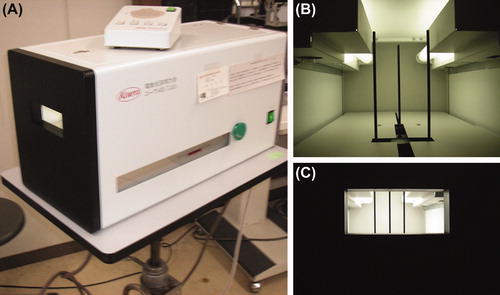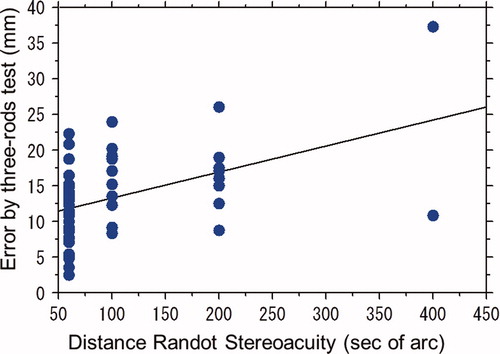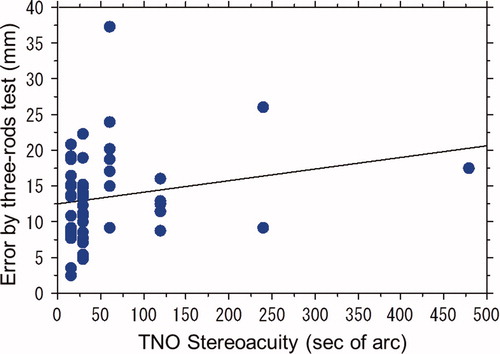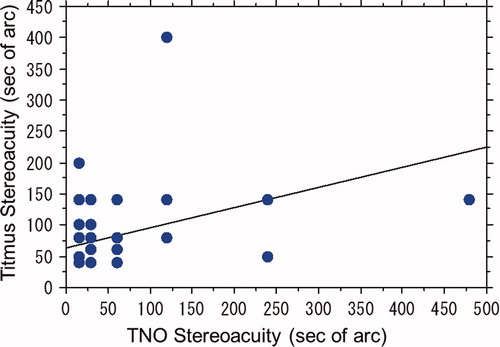Abstract
Background: The examination of depth perception with three-rods test, in addition to visual acuity testing, is required to obtain motor vehicle license to drive taxies and trucks, according to the Road Traffic Act in Japan. The aim of this study was to examine whether the results of the three-rods test would correlate with the results of static stereopsis tests, used in ophthalmic practice.
Methods: This study involved 54 normal subjects, 9 women and 45 men, with ages ranging from 18 to 25 (mean, 20.8) years. All had visual acuity of 0.8 or better with or without glasses or contact lenses correction and had no strabismus at the distant (5 m) or near (0.3 m) fixation. TNO Stereotest and Titmus Stereotest were examined at 40 cm while Distance Randot Stereotest was at 3 m. At three-rods test, a central rod was moved at the speed of 50 mm/sec forward and backward automatically against two laterally located fixed rods, placed inside the illuminated box. An examinee at the distance of 2.5 m observed the rods inside the box from a small viewing window and pushed a button to stop the central rod in alignment with the fixed rods. Erred distance (mm) of the central rod from the fixed rods as a mean of 4 measurements was correlated with stereoacuity in second of arc, measured by three kinds of the stereopsis tests.
Results: The erred distance of three-rods test was positively correlated with static stereoacuity at distance measured with Distance Randot Stereotest (ρ = 0.418, p = 0.0023, Spearman rank correlation test) and also with the other stereopsis tests at near fixation. The stereoacuity at near fixation, measured by TNO Stereotest and Titmus Stereotest, was positively correlated with each other (ρ = 0.431, p = 0.0017).
Conclusion: Three-rods test, examining depth perception, together with the response by eye-hand coordination, gave consistent results with distant static stereoacuity when measured with Distance Randot Stereotest.
INTRODUCTION
The Road Traffic Act in Japan requires vision testing for motor vehicle drivers. The vision tests include visual acuity and depth perception, as well as visual field testing in case of low visual acuity. The visual acuity in decimals of 0.7 or better in testing binocularly with both eyes open is mandatory for obtaining the ordinary license for self-driving-car drivers. In case of visual acuity worse than 0.3 in one eye, horizontal visual field of the other eye should be 150 degrees or wider on the temporal and nasal sides. The depth perception testing, in addition to visual acuity of 0.8 or better in testing binocularly with both eyes open and 0.5 or better in testing monocularly with either eye, is requested to obtain the license to drive large vehicles such as trucks and also to drive commercial cars such as taxies.
The depth perception for the motor vehicle license is stated to be examined by three-rods test in the enforcement regulations attached to the Road Traffic Act in Japan, enacted in 1960. The three-rods test was originally described by Helmholz in 1866.Citation1,Citation2 The central rod moves away and nearer to an examinee against two laterally located fixed rods. An examinee pushes a button to stop the moving central rod in alignment with the fixed rods. The erred distance of the central rod at a stop from the fixed rods, as a mean of three examinations, should be 20 mm (2 cm) or smaller to pass the three-rods test for the motor vehicle license.
The three-rods test has a merit to be done with both eyes open in a naturally viewing condition. The test examines a kind of dynamic stereopsis in response to a moving rod and also analyzes the speed of response by eye-hand coordination to push a button to stop the moving rod. Currently in daily ophthalmic and strabismological examinations, the three-rods test is not used as a standard battery of tests for stereopsis. Static stereopsis at near viewing and distant viewing is tested, for instance, by random dot figures with polarized or red-green anaglyph glasses to separate both eyes. In this study, we compared the results of the three-rods test with those of stereoscopic examinations, used in daily ophthalmic practice.
METHODS
Subjects
This study involved 54 normal subjects, 9 women and 45 men, with ages ranging from 18 to 25 (mean, 20.8) years. All had visual acuity in both eyes of 0.8 or better in decimals with or without glasses or contact lenses correction and had no strabismus at the distant (5 m) and near (0.3 m) fixation. All had no history of neurological, mental, or physical disease. The subjects were undergraduate students at Okayama University Medical School who were recruited by the two authors (RN and HS), both of whom were also undergraduate students. The participants gave informed consent to join the study. The study conformed to the tenets of the Declaration of Helsinki and was approved by the institutional review board of Okayama University Graduate School of Medicine, Dentistry, and Pharmaceutical Sciences.
Stereopsis Tests
TNO Stereotest (TNO test for stereoscopic vision, 5th edition, Lameris Ootech, Nieuwegein, The Netherlands) and Titmus Stereotest (Stereo Fly Test, Stereo Optical Company, Inc., Chicago, Illinois) were examined at 40 cm, while Distance Randot Stereotest (Stereo Optical Company) was at 3 m. The TNO Stereotest detected stereoacuity varying from 15, 30, 60, 120, 240, to 480 seconds of arc by the Plate V, VI, and VII. The Titmus Stereotest detected stereoacuity varying from 40, 50, 60, 80, 100, 140, 200, 400 to 800 seconds of arc by the figure of circles. The Distance Randot Stereotest detected stereoacuity varying from 60, 100, 200 to 400 seconds of arc.
Three-Rods Test
Three-rods test was done with Electric Depth Perception Tester (AS-7JS1, Kowa, Tokyo, Japan). Three black-colored rods with the diameter of 3 mm were placed 30 mm apart from one another (). The two peripheral rods were fixed while only the central rod was moved backward (away from an examinee) in the span of 100 mm and then forward (nearing to an examinee) in the span of 110 mm at the speed of 50 mm/second. The examinee, keeping the head straight and still without the head fixed, sat on a chair at the distance of 2.5 m apart from the fixed rods inside the box illuminated with fluorescent light. The fixed rods were located inside the box at the distance of 262 mm from the outer wall of the viewing window. The height of the chair was adjusted so as to align the examinee’s eyes with the center of the rectangular viewing window with 44 mm vertical length and 104 mm horizontal length to observe the three rods inside the box. The examinee pushed the button when he or she noticed the central moving rod in the alignment with the two peripheral fixed rods while the central rod was moving backward and forward. The examinee was instructed for these procedures and the measurements were repeated 4 times. The direction of movement of the central rod, either backward or forward, at the start of measurements, was chosen arbitrarily in each individual. The sound of a moving rod could be heard even at the measuring distance of 2.5 m.
FIGURE 1 Overview of a current standard apparatus for three-rods test in Japan (A), three black rods inside the uniformly illuminated box with white inner walls (B) and a small viewing window on the black outer frontal wall (C). An examinee sits on a chair, 2.5 m apart from the fixed rods inside the illuminated box, and observes the central moving rod through the viewing window of 44 mm vertical length and 104 mm horizontal length. The fixed rods are located inside the box at the distance of 262 mm from the outer wall of the viewing window. At the distance of 2.5 m, an examinee sees only the three rods in the background of white illumination inside the box. Note that the illuminators in the box can be observed on plate C because photographic viewing distance is too near.

The erred distance of the stopped central rod relative to the two fixed rods was recorded as a plus value (mm) when the central rod was far away, relative to the fixed rods, from the examinee, and as a minus value when the central rod was nearer, relative to the fixed rods, to the examinee. A mean of 4 measurements in an absolute value without minus or plus tags was calculated, and was tested for statistical correlation with stereoacuity in seconds of arc, obtained by the stereopsis tests (Spearman rank correlation test, StatView version 5.0, SAS Institute, Inc., Cary, North Carolina).
RESULTS
A median and a quartile in the mean erred distance of the three-rods test were 13.3 mm and 7.2 mm, respectively, with a maximum of 37.2 mm and a minimum of 2.5 mm. The mean and standard deviation of the erred distance in the three-rods test were 13.4 mm and 6.1 mm, respectively. In the Distance Randot Stereotest, both median and mode were 60 seconds of arc, with a maximum of 400 seconds of arc and a minimum of 60 seconds of arc. In the TNO Stereotest, both median and mode were 30 seconds of arc, with a maximum of 480 seconds of arc and a minimum of 15 seconds of arc. In the Titmus Stereotest, both median and mode were 40 seconds of arc, with a maximum of 400 seconds of arc and a minimum of 40 seconds of arc.
The mean erred distance in 4 measurements by the three-rods test was positively correlated with static stereoacuity measured at 3 m by the Distance Randot Stereotest (ρ = 0.418, p = 0.0023, Spearman rank correlation test, ), and also with static stereoacuity measured at 40 cm by the TNO Stereotest (ρ = 0.239, p = 0.0824, ) and Titmus Stereotest (ρ = 0.311, p = 0.0234, ). The stereoacuity at near fixation, measured by the TNO Stereotest and Titmus Stereotest, positively correlated with each other (ρ = 0.431, p = 0.0017, ). The stereoacuity at distance measured with the Distance Randot Stereotest also showed correlation with the stereoacuity at near fixation measured by the TNO Stereotest (ρ = 0.356, p = 0.0095) and Titmus Stereotest (ρ = 0.326, p = 0.0177).
FIGURE 2 Mean erred distance in 4 measurements by three-rods test and stereoacuity measured at 3 m by Distance Randot Stereotest. Significant positive correlation is noted between the erred distance and the distant stereoacuity (ρ = 0.418, p = 0.0023, Spearman rank correlation test).

FIGURE 3 Mean erred distance in 4 measurements by three-rods test and stereoacuity measured at 40 cm by TNO Stereotest. Positive correlation, although not significant, is noted between the erred distance and the near stereoacuity (ρ = 0.239, p = 0.0824, Spearman rank correlation test).

DISCUSSION
The goal of this study was to evaluate the three-rods test from the viewpoint of stereopsis tests, performed as standard stereoscopic tests in ophthalmic clinics. The three-rods test has been enforced as a standard vision test since 1960 to obtain and maintain a driver’s license for commercial cars or large vehicles, such as taxis and trucks. Since then, several types of stereopsis tests for near vision, such as the TNO Stereotest and Titmus Stereotest, have been developed commercially and used largely in the clinical setting. More recently, the Distance Randot Stereotest has been developed to measure stereopsis in distant viewing condition.Citation3,Citation4 These stereopsis tests for near and distant viewing utilize binocular dissociation by wearing red-green anaglyph or polarized glasses. In contrast, the three-rods test is done in natural viewing conditions with no binocular dissociation. Furthermore, the three-rods test basically checks motion stereopsis while the other stereotests check static stereopsis.
We used in this study a current standard apparatus to perform the three-rods test for the motor vehicle license (). The apparatus is designed to place three black-colored rods inside the uniformly illuminated box with white-colored inner walls and to let an examinee at the distance of 2.5 m observe the rods from a small viewing window on the black-colored outer frontal wall. This design is aimed to avoid the different kinds of monocular cues possible in the testing condition. Since the head of an examinee was not strapped to a fixed head stand, the effect of motion parallax still remains a confounder in this real-depth testing. Under the circumstances, we examined the individuals only in binocular viewing conditions for the three-rods test as well as the other stereotests, but did not perform any test in monocular viewing conditions.
In this study, we did not evaluate static three-rods tests because the visual requirements for obtaining the motor vehicle license in Japan state dynamic three-rods test. Based on this line of the rule, an apparatus for examining depth perception is designed to perform the dynamic three-rods test. Another test available for measuring distance stereoacuity on static condition is the Frisby Davis Distance (FD2) Stereotest, which does not require binocular dissociation.Citation5,Citation6 We chose Distance Randot Stereotest for comparison in this study because of its familiarity in our clinical setting.
The present study demonstrated that the mean erred distance in the three-rods test was significantly correlated with stereoacuity at distant viewing, measured by the Distance Randot Stereotest. Smaller errors in the alignment of the moving central rod with the two fixed rods were associated with better stereoacuity at distant viewing. In addition, the mean erred distance in the three-rods test showed significant correlation with stereoacuity at near viewing. The present study also showed strong positive correlation with stereoacuity at near viewing, measured by the TNO Stereotest and Titmus Stereotest, supporting indirectly the reliability of the testing results in the present study.
It is surprising to find that some individuals joining in this study showed poor stereoacuity at near and distance. Of course, stereoacuity is well known to vary even in normal people with similar age.Citation7 The inclusion criteria in this study were corrected or uncorrected visual acuity of 0.8 or better in both eyes, no manifest strabismus at near and distance, and no past or present history of neurological, mental, or physical diseases. Under the circumstances, we did not designate each individual as normal and also did not assume a cut-off value for the normal range of stereopsis. Therefore, we used a non-parametric correlation test for analyzing the relationship between the data obtained by three-rods test and different kinds of stereotests. A limitation of this study would be that no data on test-retest variability were obtained in three-rods test or in other stereotests.
The enforcement regulations of the Road Traffic Act in Japan state that the mean erred distance of 3 measurements should be 20 mm (2 cm) or smaller to pass the three-rods test as depth perception testing. The value of 20 mm at 2.5 m in a linear measure is calculated as equivalent to 28.8 seconds of arc. As far as we have searched in the literature, we could not find any scientific evidence to support the normal range at the three-rods test. In the present study, only 4 of 54 individuals failed to show the mean erred distance of 20 mm or smaller in 4 measurements of the three-rods test. In addition, the median of the erred distance was 13.3 mm with the quartile of 7.2 mm, while the mean and standard deviation were 13.4 mm and 6.1 mm, respectively, indicating altogether that about three-quarters of the normal individuals in this study showed the erred distance of 20 mm or smaller. These results support that the current threshold for passing the three-rods test would be reasonable from the statistical point of view. However, the other side of the coin in the present results is the fact that 4 normal individuals could not pass the three-rods test at the current standard for the driver’s license.
In conclusion, this study is the first, to the best of our knowledge, to evaluate the results of the three-rods test from the viewpoint of static stereopsis tests for near and distant viewing, used frequently in the clinical setting of ophthalmological examinations. The results of the three-rods test did show significantly positive correlation with stereoacuity at distant viewing, examined by the Distance Randot Stereotest, and also showed positive correlation with stereoacuity at near viewing, examined by the TNO Stereotest and Titmus Stereotest. The three-rods test has been used as the part of vision tests for driver’s licenses, not only in Japan but also in the other countries such as Germany.Citation8–11 The three-rods test, therefore, has social impact as a screening test for drivers’ license. Continuous evaluation of the three-rods test would be required from the viewpoint of standard ophthalmological examinations, as demonstrated in the present study.
Declaration of interest
The authors declare no conflicts of interest. This research received no specific grant from any funding agency in the public, commercial, or not-for-profit sectors. All authors did not have any competing interests in this research.
References
- Kani W. Stereopsis and spatial perception in amblyopes and uncorrected ametropes. Br J Ophthalmol 1978;62:756–762
- Zagora E. The Zagora rod test. Br J Ophthalmol 1957;41:188–189
- Fu VLN, Birch EE, Holmes JM. Assessment of a new Distance Randot Stereoacuity Test. J AAPOS 2006;10:419–423
- Wang J, Hatt SR, O’Connor AR, et al. Final version of the Distance Randot Stereotest: normative data, reliability, and validity. J AAPOS 2010;14:142–146
- Holmes JM, Fawcett SL. Testing distance stereoacuity with the Frisby-Davis 2 (FD2) test. Am J Ophthalmol 2005;139:193–195
- Adams WE, Hrisos S, Richardson S, et al. Frisby Davis distance stereoacuity values in visually normal children. Br J Ophthalmol 2005;89:1438–1441
- Zaroff CM, Knutelska M, Frumkes TE. Variation in stereoacuity: normative description, fixation disparity, and the roles of aging and gender. Invest Ophthalmol Vis Sci 2003;44:891–900
- Hartmann E, Stocker L. [The importance of depth perception in work-places and in road traffic]. Fortschr Ophthalmol 1983;80:496–497
- Sachsenweger M, Sachsenweger U. Stereoscopic acuity in ocular pursuit of moving objects. Dynamic stereoacuity and movement parallax: relevance to road safety and occupational medicine. Doc Ophthalmol 1991;78:1–133
- Fleck R, Kolling GH. Two new stereotests for long distance: examination of stereopsis with regard to the permission of driving. Ger J Ophthalmol 1996;5:53–59
- Bauer A, Dietz K, Kolling G, et al. The relevance of stereopsis for motorists: a pilot study. Graefes Arch Clin Exp Ophthalmol 2001;239:400–406



